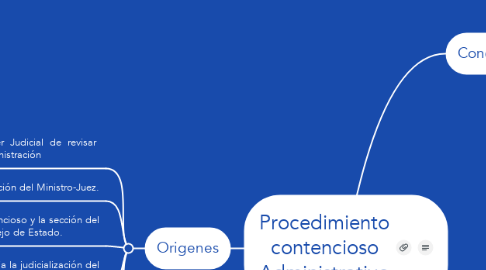
1. Origenes
1.1. Imposibilitado el Poder Judicial de revisar los actos de la Administración
1.2. La solución del Ministro-Juez.
1.3. La Comisión del contencioso y la sección del Contencioso del Consejo de Estado.
1.4. La tendencia hacia la judicialización del contencioso-administrativo francés
1.5. 1953 se crean los Tribunales Administrativos provinciales
1.6. En la actualidad
1.6.1. Training
1.6.2. Channels
1.6.3. International
1.6.4. Public Sector
1.6.5. Sales
1.6.6. Marketing Communications
1.6.7. Product Management
2. Concepto
2.1. conjunto de litigios nacidos de los actos administrativos
2.2. operaciones materiales de la Administración contrarios a derecho
2.3. contencioso o controversia con la Administración
2.4. un acto ilegal o ilegitimo o por una actuación administrativa
2.5. originada bien en un acto administrativo ilegal, o respecto a un derecho subjetivo lesionado...
3. Origenes
3.1. La interpretación de los Revolucionarios Franceses
3.1.1. Situational Analysis / Drivers
3.1.1.1. What is driving us to do this?
3.1.1.2. SWOT Analysis
3.1.1.2.1. Strengths
3.1.1.2.2. Weaknesses
3.1.1.2.3. Opportunities
3.1.1.2.4. Threats
3.1.1.3. Customer Findings - What have we learned from customers?
3.1.2. Competitive Analysis
3.1.2.1. Do we have competitors and threats in these target markets with the proposed offerings?
3.1.2.2. What are our competitors doing and how are they positioning?
3.1.2.3. How do we position against each competitor?
3.1.3. Target Customer(s)
3.1.3.1. Buyer Profile
3.1.3.1.1. Title
3.1.3.1.2. Industry
3.1.3.1.3. Geography
3.1.3.1.4. Business Size
3.1.3.2. Influencer Profile
3.1.3.3. User Profile
3.1.3.4. What do customers want and need?
3.1.3.5. What business problems do each of these customers have?
3.1.4. Customer Segmentation
3.1.4.1. Which customers or sets of customers do we sell to?
3.1.4.2. What are the target market segments that we want to go after?
3.1.4.3. What are the distinct problems for each segment of the market?
3.1.5. Total Available Market
3.1.5.1. New Prospects
3.1.5.1.1. How much of each target segment have we penetrated?
3.1.5.1.2. How much opportunity is available in each target segment?
3.1.5.2. Existing Customers
3.1.5.2.1. Can we up-sell existing customers?
3.2. dogma de la separación de poderes
3.2.1. Service Offer
3.2.1.1. What are we selling?
3.2.1.2. Product Definition
3.2.1.3. Pricing
3.2.1.4. Packaging
3.2.1.5. Positioning
3.2.2. Value Proposition
3.2.2.1. What is the Value Proposition to the Customer?
3.2.2.2. What pain are we solving?
3.3. desconfianza hacia el Poder Judicial
3.3.1. Revenue Forecasts
3.3.1.1. Revenue and P&L Forecast (5 Years)
3.3.1.2. Revenue should be split out quarterly
3.3.2. Cost Analysis
3.3.2.1. Should include a description of the costs in entering this business and profitability analysis
3.3.3. Profitability Analysis
3.3.3.1. P&L for the offer to include gross margin, net income and break even analysis.
3.4. Francia prerrevolucionaria de los últimos años del siglo XVIII entre los Parlamentarios
3.4.1. Sales Strategy
3.4.1.1. Direct Sales Strategy
3.4.1.2. Inside Sales Strategy
3.4.1.3. Channel Sales Strategy
3.4.2. Partner Strategy
3.4.2.1. Channel Strategy
3.4.2.1.1. What 3rd party channels should we consider for reselling this service?
3.4.2.2. Technology Partnerships
3.4.2.2.1. What technology vendors (if any) do we need to work with to execute on this plan?
3.4.2.3. Solutions Partners
3.5. nueva Administración surgida de la Revolución
3.5.1. Positioning & Messaging
3.5.1.1. What is the key messaging and positioning for the service offer? (Pain, alternatives, solution)
3.5.1.2. How do we communicate internally?
3.5.1.3. How do we communicate externally?
3.5.2. Promotion Strategy
3.5.2.1. Marketing Programs (Installed base versus new prospects)
3.5.2.2. Advertising (Publications, etc.)
3.5.2.3. Analyst Relations (Target Analysts)
3.5.2.4. Public Relations
3.5.2.5. Events (Trade shows, SEO/SEA, Seminars)
3.5.2.6. Webinars
3.5.3. Demand Generation & Lead Qualification
3.5.3.1. How do we generate and qualify new leads for the target offer?
3.5.3.2. Prospect Lists
3.5.3.3. Key Questions to Ask
3.5.3.4. Sales Collateral
3.5.3.5. Presentations
3.5.3.6. Data Sheets
3.5.3.7. White Papers
3.5.3.8. ROI Tools
3.5.3.9. Other Sales Tools (web site, etc.)
3.6. injerencia del Poder Judicial en la actividad administrativa
3.6.1. Numbers, budget, waterfall, break-even (cost>leads>trials>deals)
3.6.2. Sales Programs
3.6.3. Accelerated Learning Strategy, Controls, Metrics
3.6.4. Include feedback loops
3.6.5. Include financial metrics (definition of success)
3.6.6. Pipeline reports, etc…
3.7. imposibilidad para los órganos del Poder Judicial de entrar a revisar la conformidad a Derecho de los actos dictados por la Administración.
3.7.1. M&A?
3.7.2. Risk Analysis & Mitigation
